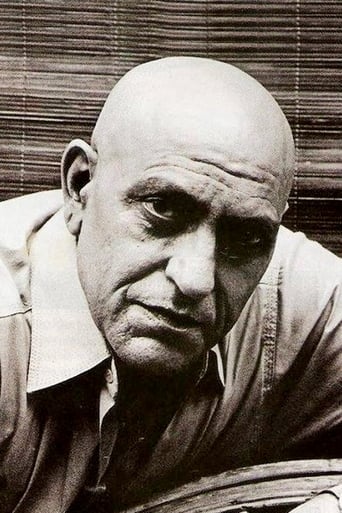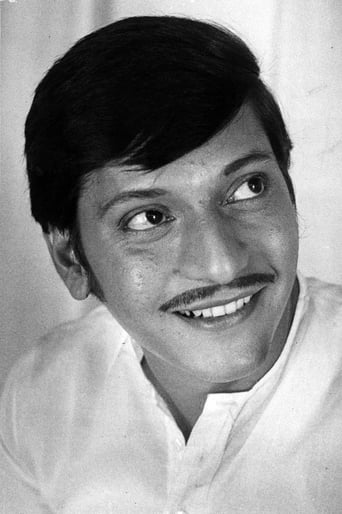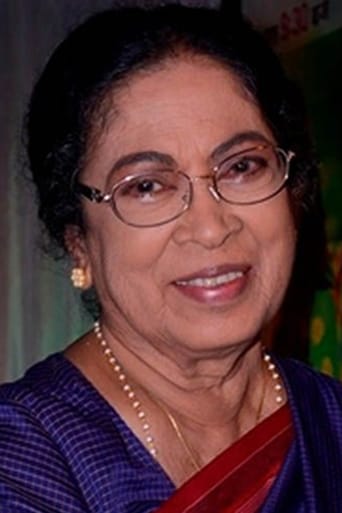Scanialara
You won't be disappointed!
Gurlyndrobb
While it doesn't offer any answers, it both thrills and makes you think.
filippaberry84
I think this is a new genre that they're all sort of working their way through it and haven't got all the kinks worked out yet but it's a genre that works for me.
Philippa
All of these films share one commonality, that being a kind of emotional center that humanizes a cast of monsters.
varuna12
Bhumika (1977) - A film by Shyam Benegal Sahab'Bhumika - The Role' is probably the best role ever played by Smita Patil in her career. 'Usha' the character played by her is throughout her life seeking happiness but she never attains. She falls in love and romantic liaisons with a number of men each of whom ends up unsatisfying her emotionally. One is weak and lacks confidence, another is too over the top philosophically who even hates the concept of 'love', another one almost deceives her with charm and confidence only later letting her realize that she will be a prisoner of his family traditions and their culture which won't even allow a women to step outside his house after death.In the end she is rescued by the man called Keshav, superbly played by Amol Palekar. He is in the first place the reason for all her misery to begin with. He has his own personal needs and agendas. He sees an opportunity to exploit young Usha's charm and abilities and gets her into the film business, convincing her mother with perhaps deceiving arguments and assurances. A young Usha was only supposed to be in the profession for three or fours years but we are introduced to her character when she is her late 30s or early 40s and still in the same business.Shyam Benegals Sahab has made a brilliant film which for majority of its running time runs in the flashbacks. A shoot is taking place. A mild twisting of an ankle by one of the background dancers halts the shoot where Usha is the lead. Since the scene cannot be completed the director decides to call for packup.Usha doesn't have any scenes so she can go home. From the this early moment in the film one can start to see her unhappiness. She was delightfully cheerful for the eyes and the mind while she was in front of the camera. As soon as she is back in the real world, she looks sad and disturbed and a bit gloomy. This is further established by an un- importantly tiny gesture that his fellow actor makes for her by giving her a lift back home which irritates Keshav, her much older husband.It is at this moment in story when the character Keshav is introduced. By his very looks and super makeup and costume, and on top his brilliant performance by Amol Palekar, we can anticipate and predict that the forthcoming interaction between the two characters is not going to be pleasant.Director Sahab doesn't waste any time in any illogical and unnecessary melodrama and instead take the story right to the point. After this brief interaction and her expression of angst and frustration we come to know that this is a common occurrence in her life. This leads to an argument which is followed by Usha walking out of the house and taking a refuge in hotel.It is at this familiar hotel in her familiar room that the flashbacks start. The very first flashback is of Usha's childhood which is brilliantly shot in black and white. A much younger looking Amol Palekar and Sulabha Deshpande who plays Usha's mother and a young Usha played by little girl (sorry couldn't find her name) perform with such sheer brilliance and conviction that you are suddenly taken back in their times and you get a feeling of actually being there.I can keep on going about this film with its wonderful cinematography, direction, editing and performances but I'll cut the chase out and get climax of my point!JUST WATCH THIS FILM!!!! It's a MUST WATCH!!!I feel like punching myself in face for not having seen this film earlier!Hats off to Shyam Benegal Sahab, Smita Patil and a very brilliant Amol Palekar sahab.
Peter Young
Shyam Benegal's Bhumika: The Role is an example of superb, masterful cinema. The film relates the life story of a troubled actress named Usha Dalvi from her very childhood to her adulthood, and slowly follows her trials and tribulations, her coming of age, her relationships with different men, her despair, and finally her self-acceptance. Benegal partly adopts the style of Satyajit Ray's film-making and the film's first sequences remind me of Ray's Pather Panchali in the way it presents the childhood of Usha. These scenes are extremely well shot and let the viewer identify with the little girl and sense her simple and miserable yet memorable childhood. Benegal's direction is absolutely brilliant. Everything in the film represents his unique technique. The use of black and white photography for sequences from the past, the static camera work, the silent moments, the attention to the smallest of characters - all contribute to the film's dark, deep and serious tone and make the narrative style believable. The screenplay is fantastic and the story unfolds through undertones in a simple and natural way. It is all about subtlety and striking realism.Smita Patil is simply exceptional as the main protagonist Usha. She gets a role which is both demanding and difficult and plays it with complete conviction, ease and intensity. Her character has many shades and that's where the film probably takes its title from. Every new phase in her personal life is similar to the previous - she virtually gets the same script, the same role. She played many roles but never could play her own self. We really feel for Usha as we witness her experiences, confusion and dissatisfaction from life, and that's thanks to Patil, who displays something very disturbing within her. She naturally shows the growth of her character and the power of her emotions through her expressive eyes and stark silence. This really is an unforgettable portrait of a celebrated yet unhappy woman from one of the most talented actresses ever. Apart from Patil, who is the film's owner, every actor without exception stands out. Sulabha Deshpande is excellent as Usha's mother, Amol Palekar is incredible as her devious husband. Naseeruddin Shah, Anant Singh, Amrish Puri and Dina Pathak are equally competent although they have much smaller parts.All-in-all, Bhumika is an extraordinary piece. The film can be described as a drama but it is dramatic in a very different way from the usual Hindi films. As can be expected from a Shyam Benegal picture, you won't find here the dramatisation and the clichés one uses to associate with Hindi movies, there are no songs (only in film shooting scenes), no tear-jerking or larger-than-life dialogues, it is genuinely real, and although many would find it overly slow and banal, it is thoroughly fascinating and only grows on the viewer as it goes by. It not only gives us an insight into the complexity of human nature and relationships, but also a glimpse into the world of cinema and the life in the rural India with all its principles, values and difficulties, whether social or financial. It is one of the film's strongest depictions. Usha's transitions from one life to another, from one house to another, from one man to another, and the fact that every story is similar to another and that she herself does not know what she wants and how to deal with it really explain the meaning of the film. All of us have many roles to play, and at some point we will have to decide what role remains the most crucial to us and how we want to play it. This may be the main point of this rare gem.
Alice Liddel
For years I had been lead to believe that the Indian cinema basically consisted of the florid excesses of Bollywood and the restrained humanism of Satyajit Ray. No-one told me that it could be as marvellous as this, combining the vibrant, visual energy of Bollywood, the depth of character of Ray, with a narrative complexity, formal daring, and willingness to experiment alien to both. Like that other overwhelming Indian masterpiece I experienced recently, 'The Cloud-Capped Star', the film betrays a knowledge and mastery of the Hollywood melodrama, taking not only its visual cue from it (compositions that constrict characters; lighting and editing that reflect sensibility rather than reality etc.), but its use of a despised, populist form to create a charged, critical work. Many of the characters recur through Indian cinema - the workshy men who produce only dreams, sapping their families; the women forced to become breadwinners in a rigidly patriarchal society, often becoming hardened and soul-calloused in the process; the children who seem to breathe the fresh air of a freer future, but are eventually suffocated by tradition and circumstance. And Benegal doesn't stint on the melodramatic aspects. The expected emotional rollercoaster is here - quiet joys (a walk in a beautiful countryside; joking about with friends) alternating with scenes of harrowing violence (the beating of a young girl; the dragging of an unfaithful wife to swear fidelity before an altar). What is different from Ray, say, is that these are put into an intelligently worked out context. Not some spurious historical one - Rajan listens to the radio droning, useful for giving us chronological markers otherwise absent. People's lives don't change in spite of the shattering historical events going on we normally think of as important. Benegal is interested in the lives that exist parallel to official history, that remain untouched.
this is where his complex narrative framework comes into effect - the present story punctuated by sepia flashbacks. This format is now a narrative cliche, but Benegal richly patterns his, creating a vicious circle imprisoning his heroine, doomed to repeat the mistakes of her mother and grandmother, just, we fear, as her daughter and granddaughter will repeat hers. Trapped in a loveless marriage, or, later, literally in the house of a fundamentalist lover, she is also trapped in time, in narrative, as a woman in a society where being a woman is a role, it doesn't matter who fills it. The film is full of repetitions, of the heroine being brought back to scenes again and again, situations, people. The pretexts for these scenes may change, but their fundamental character - someone else wielding power over her - remains unaltered; any escape can only lead to humiliation, degradation, violence, becoming an outcast, a broken non-person, stripped of a role that is not life-defining, but life itself.This is why 'The Role' is such a brilliant film about films; not naval-gazing about itself like Hollywood or il Maestro, but showing how popular modes can reinforce certain roles for their audience. The heroine may be an actress, but there are no paparazzi or glitzy cars here: for all her popularity, she is socially despised. ironically, although the Bollywood movies she stars in may seem formulaic, they give her an acceptable forum with which to express her anguish - as well as allowing her the freedom to try out roles (including a gender-bending swashbuckler), and to question assumptions, normally denied her in real life. The film may reveal the gap between fantasy and reality, but the distinction is never THAT easy.
ajji-2
Excellent performance by the late Smita Patil energizes this story of a girl who is manipulated by almost every man she meets in the film industry. it may sound sordid, but credit goes to the director as well as the actors for handling the material with grace. that final scene where she talks to her daughter over the phone, is a classic example.






